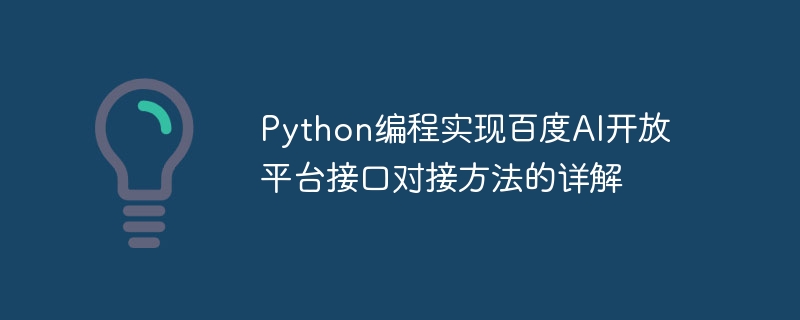

Detailed explanation of the interface docking method of Baidu AI open platform through Python programming
In the context of the development of modern science and technology, artificial intelligence (AI) technology is gradually becoming an integral part of all walks of life. hot topics. As China's leading Internet company, Baidu also has a lot of innovation and investment in the field of AI. The Baidu AI open platform provides a rich API interface, allowing developers to easily use the functions of Baidu AI. This article will explain in detail how to use Python programming to connect to the Baidu AI open platform interface, and attach code examples.
First, we need to register and create an account on Baidu AI Open Platform. After the creation is successful, we can obtain the API Key and Secret Key for interface calling in the console. These two keys are important parameters to ensure the security of interface calls, so they must be kept properly.
Next, we need to install Python's requests library, which is a commonly used HTTP library that can help us send HTTP requests and process responses.
In the code, we first need to import the requests library, and then define a method to send a POST request to call the interface of Baidu AI open platform. The specific code is as follows:
import requests
import json
def baidu_api_request(url, params):
headers = {
'Content-Type': 'application/json',
}
params['access_token'] = YOUR_ACCESS_TOKEN
response = requests.post(url, headers=headers, data=json.dumps(params))
result = response.json()
return resultThe url parameter in the above code is the interface URL that needs to be called, and the params parameter contains the parameters required by the interface. We set the Content-Type in the headers to application/json to indicate that the requested data type is in JSON format.
def baidu_api_request(url, params):
headers = {
'Content-Type': 'application/json',
}
params['access_token'] = YOUR_ACCESS_TOKEN
response = requests.post(url, headers=headers, data=json.dumps(params))
result = response.json()
return resultIn specific use, we only need to call this method and pass in the corresponding interface URL and parameters. Before calling, we need to assign the Access Token we obtained when creating the application on Baidu AI Open Platform to params['access_token']. Access Token is a temporary authorization credential, valid for 30 days, and can be obtained by calling the interface.
After the interface is called successfully, we can obtain the return data of the interface through result. Depending on the specific interface functionality, the format of the returned data may vary.
The following takes the text recognition interface in Baidu AI open platform as an example to demonstrate the docking method. This interface can realize the recognition function of text in pictures.
First, create a text recognition application on the Baidu AI open platform and obtain the API Key, Secret Key and Access Token.
Then, we can use the following code to call the text recognition interface:
API_URL = "https://aip.baidubce.com/rest/2.0/ocr/v1/accurate_basic"
ACCESS_TOKEN = "YOUR_ACCESS_TOKEN"
def recognize_text(image_path):
url = "{}?access_token={}".format(API_URL, ACCESS_TOKEN)
image = open(image_path, 'rb').read()
params = {
'image': base64.b64encode(image),
'language_type': 'CHN_ENG',
}
result = baidu_api_request(url, params)
if 'words_result' in result:
words_result = result['words_result']
for word in words_result:
print(word['words'])
else:
print("Recognize failed")
image_path = "test.png"
recognize_text(image_path)In the above code, you need to replace API_URL with the URL of the interface, and replace ACCESS_TOKEN with what we have in Baidu AI Open Platform Access Token obtained on. image_path is the image path that needs to be identified.
After running the code, we can see the text recognized in the picture.
Through the above examples, we can see that the Python programming language combined with the interface of Baidu AI open platform can easily implement various functions, such as text recognition, speech synthesis, face recognition, etc. Developers can flexibly use Baidu AI's interface according to specific needs and integrate it into their own applications.
In short, Baidu AI open platform provides a rich API interface, and Python, as a concise and easy-to-learn programming language, can be used well with it. By calling interfaces and processing return data, we can implement various powerful artificial intelligence functions. I hope this article can help readers who are interested in Baidu AI interface docking.
The above is the detailed content of Detailed explanation of the interface docking method of Baidu AI open platform through Python programming. For more information, please follow other related articles on the PHP Chinese website!




